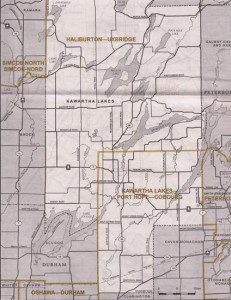
Ottawa, I have learned, has the power to do many things. The federal government can influence the nation’s economy, with Bank of Canada interest rates, stimulus funding and, of course, taxation. It can choose to send the country’s armed forces to war. Ultimately, it has the power to draft, debate and generate the laws that change the lives of all Canadians. But this week, when I opened up one of the Toronto daily newspapers, a special federal government insert dropped out. And I discovered the feds have even greater power than I thought.
“Canada’s electoral map is changing,” the cover of the insert said. “Read about the proposed new electoral map for Ontario.”
If you turn to page 20 (containing Map 12 which shows the proposed new electoral district, called “Haliburton-Uxbridge,”) you might be surprised to note that the district does not contain half of its namesake.
That is, the proposed new constituency in which my fellow constituents and I will someday elect a new member of Parliament, doesn’t even have Uxbridge contained in it! Odd, that a federal agency charged with the responsibility of redrawing the lines of our voting areas would not know where Uxbridge is!
I mean, we in this community have sometimes come to expect, being located some distance from the higher-populated, more influential centres of the GTA (such as Pickering, Ajax, Whitby and Oshawa), that we might not have a lot of voice. But to be left completely off the map containing a proposed new constituency with our name in it, strikes me as insulting. Just where are the decision-makers in the Harper government taking this country, when they don’t even know their own geography?
But that’s not the only landscape that seems to be changing in Canada. While it’s not a matter of physical geography, Bell Canada Enterprises’ (BCE) planned purchase of Astral Media for $3.4 billion has the potential to change life in your living room (or wherever you choose to watch television, listen to radio or surf on your computer).
If the merger, which is currently under review by the Canadian Radio, Television and Telecommunications Commission (CRTC), goes through, Bell (which already owns the Globe and Mail and CTV) would absorb 70 additional television channels and approximately 100 radio stations, not to mention the hundreds of websites associated.
How does that change the Canadian landscape? Well, the last time Bell Canada’s monopoly changed – when it began bundling its media after the purchase of CTV and TSN – consumer package rates jumped more than 100 per cent. BCE’s control of the media marketplace increased to more than 80 per cent. My view is that if you concentrate all that power in one media conglomerate, radio and TV stations will be closed and Canadians will lose community voice.
They will also lose choice because all BCE stations will begin to replicate the same news across their network. And the cost to the consumer will rise; the last time BCE swallowed a chunk of Canadian media (CTV and TSN) consumer package rates jumped from $18.70 to $44. I take heart, however, in the introductory remarks of the new chair of the CRTC at the hearings this week.
“I would remind everyone that it is the responsibility of a seller or their representative to prove that a transaction is in the public interest,” Jean-Pierre Blais told the Globe and Mail on Monday.
It appears, as well, that federal governments, like monopolies, have the power to change geography in more ways than just the media landscape and electoral districts. This week, right out of the blue, John Baird, minister of foreign affairs, announced Canada was cutting off all economic and diplomatic ties with Iran. Minister Baird, no doubt directed by the Prime Minister, told Canadians that Iran is a rogue state, that it must undergo regime change and that Iranian diplomats in Canada had five days to pack and leave.
“Canada,” he told reporters, “views the government of Iran as the most significant threat to global peace and security in the world today.”
Well, on the one hand, Baird is right. Iran’s regime is corrupt. It is anti-Semitic. It does threaten the Middle East and beyond with its attempts to develop nuclear weapons and their delivery systems. And yes, since the revolutionary takeover in Iran by Ayatollah Khomeini in 1979, the kidnapping of the entire U.S. diplomatic staff back then, and denial of free elections in recent years, it’s clear Iran’s Mahmoud Ahmadinejad is just another well-armed despot. But wouldn’t it make a bit more sense to have even diplomatic contact with a tyrant you dislike, to know what he’s up to, than to cut him off as if he doesn’t exist?
Seeing no evil and hearing no evil doesn’t mean there is no evil. It’s kind of like redrawing electoral boundaries. Go ahead, bury your head in the sand, but check your atlas first.